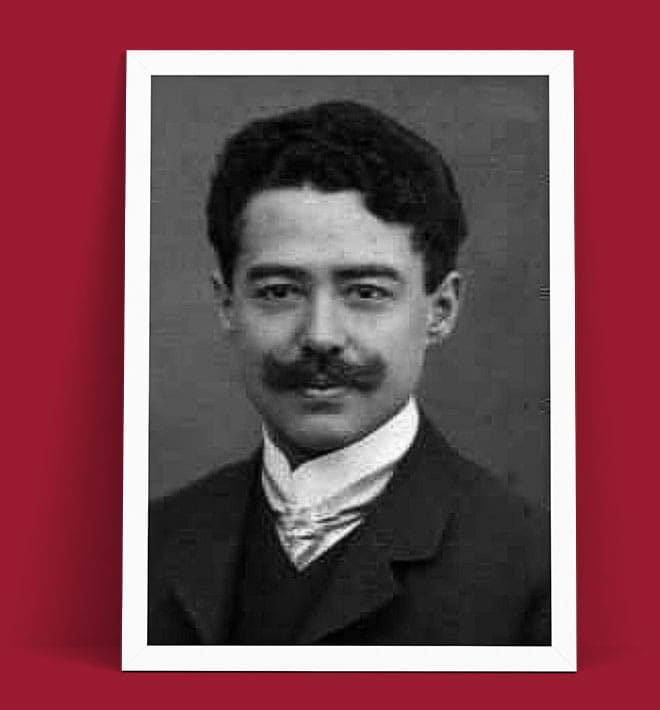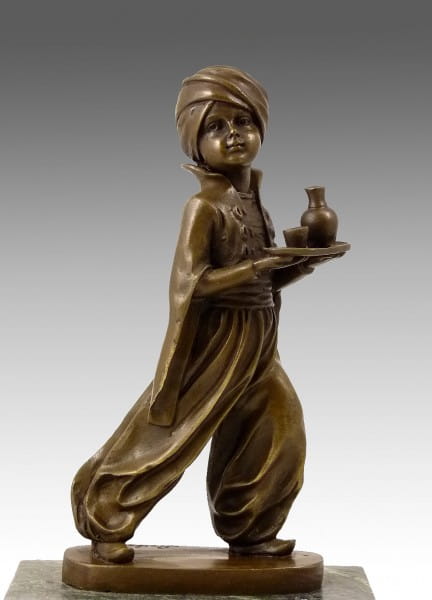€299.00 *
Prices incl. VAT, free shipping worldwide
Ready to ship today,
Delivery time appr. 3-6 workdays










Art Deco Bronze Figure - "Sarotti Mohr" - Advertising Figure by Ferdinand Preiss The... more
Product description
"Art Deco Bronze Figure - Sarotti Mohr - by Ferdinand Preiss"
| Weight | 3 kg |
Art Deco Bronze Figure - "Sarotti Mohr" - Advertising Figure by Ferdinand Preiss
The Sarotti Mohr by Ferdinand Preiss is a unique blend of commercial art and cultural symbolism, crafted during the height of the Art Deco era. Known as a prominent advertising figure, this bronze sculpture embodies both the refined craftsmanship of Preiss and the spirit of cultural fascination that was prevalent in early 20th-century Europe. Originally created as a promotional figure for the German chocolate brand Sarotti, the Sarotti Mohr has since become a cultural icon in its own right.
About the Artist: Ferdinand Preiss
Ferdinand Preiss was born on February 13, 1882, in Erbach, Germany, a town known for its ivory carving. Preiss became one of the leading figures in the Art Deco movement, renowned for his ivory and bronze sculptures that captured the grace and dynamism of human figures. Preiss's work often reflects a fascination with exoticism and the elegance of the human form, placing him at the forefront of the decorative arts of his time. His creations, characterized by precision and beauty, are highly sought after by collectors today, symbolizing the height of Art Deco artistry.
The Birth of Sarotti Mohr - An Icon of Advertising and Art Deco
The Sarotti Mohr was designed around the 1920s as a branding figure for Sarotti, a popular German chocolate company. The figure was part of an advertising campaign to personify the luxury and "exotic" appeal of chocolate, a product often associated with distant lands. This figure served as the brand’s mascot, depicting a young boy with a turban and traditional attire, holding a tray, which symbolized the company’s "Oriental" theme—a marketing trend that was typical of the time, aiming to attract consumers by evoking a sense of exoticism.
This Art Deco piece reflects both Preiss's artistry and the commercial culture of the 1920s and 1930s, when advertisers sought to create strong, memorable icons. While the figure is a product of its time, embodying a dated perspective of "the Orient," it also showcases the artistry and craftsmanship that Preiss brought to his work, merging fine art with commercial appeal.
Artistic Details of Sarotti Mohr
The Sarotti Mohr is designed in classic Art Deco style, marked by clean lines, smooth surfaces, and a stylized form. The boy is adorned in a turban and loose-fitting attire, with intricate detailing that showcases Preiss’s attention to texture and fabric. His posture is both poised and inviting, symbolizing the elegance and allure associated with the Sarotti brand. The figure is typically mounted on a polished base, enhancing its display value and emphasizing the statue's refined silhouette.
The Sarotti Mohr by Ferdinand Preiss is a unique blend of commercial art and cultural symbolism, crafted during the height of the Art Deco era. Known as a prominent advertising figure, this bronze sculpture embodies both the refined craftsmanship of Preiss and the spirit of cultural fascination that was prevalent in early 20th-century Europe. Originally created as a promotional figure for the German chocolate brand Sarotti, the Sarotti Mohr has since become a cultural icon in its own right.
About the Artist: Ferdinand Preiss
Ferdinand Preiss was born on February 13, 1882, in Erbach, Germany, a town known for its ivory carving. Preiss became one of the leading figures in the Art Deco movement, renowned for his ivory and bronze sculptures that captured the grace and dynamism of human figures. Preiss's work often reflects a fascination with exoticism and the elegance of the human form, placing him at the forefront of the decorative arts of his time. His creations, characterized by precision and beauty, are highly sought after by collectors today, symbolizing the height of Art Deco artistry.
The Birth of Sarotti Mohr - An Icon of Advertising and Art Deco
The Sarotti Mohr was designed around the 1920s as a branding figure for Sarotti, a popular German chocolate company. The figure was part of an advertising campaign to personify the luxury and "exotic" appeal of chocolate, a product often associated with distant lands. This figure served as the brand’s mascot, depicting a young boy with a turban and traditional attire, holding a tray, which symbolized the company’s "Oriental" theme—a marketing trend that was typical of the time, aiming to attract consumers by evoking a sense of exoticism.
This Art Deco piece reflects both Preiss's artistry and the commercial culture of the 1920s and 1930s, when advertisers sought to create strong, memorable icons. While the figure is a product of its time, embodying a dated perspective of "the Orient," it also showcases the artistry and craftsmanship that Preiss brought to his work, merging fine art with commercial appeal.
Artistic Details of Sarotti Mohr
The Sarotti Mohr is designed in classic Art Deco style, marked by clean lines, smooth surfaces, and a stylized form. The boy is adorned in a turban and loose-fitting attire, with intricate detailing that showcases Preiss’s attention to texture and fabric. His posture is both poised and inviting, symbolizing the elegance and allure associated with the Sarotti brand. The figure is typically mounted on a polished base, enhancing its display value and emphasizing the statue's refined silhouette.
The Influence of Orientalism in Art Deco
During the Art Deco period, many European artists were captivated by Orientalism—a fascination with Eastern cultures that manifested in art, fashion, and advertising. The Sarotti Mohr reflects this trend, blending elements of traditional Eastern attire with the sleek modernism of Art Deco design. This figure not only served as an advertising tool but also as a piece of cultural representation, albeit through a lens shaped by early 20th-century perceptions.
The Legacy of Sarotti Mohr and its Cultural Impact
While initially created as an advertising figure, the Sarotti Mohr has evolved over the years into a collectible item with historical and artistic significance. Today, it stands as a reflection of both the marketing practices and artistic expressions of its time. Collectors value it not only for its aesthetic appeal but also for its role in the history of commercial art.
As social perspectives evolved, the figure also sparked discussions about representation and cultural sensitivity, becoming an artifact of the evolving relationship between art, commerce, and cultural identity. The Sarotti Mohr thus occupies a unique place, bridging the worlds of fine art and commercial advertising while sparking reflection on changing societal norms.
Ferdinand Preiss’s Enduring Influence
Preiss’s legacy as a master sculptor lives on through his timeless works, which remain highly collectible and cherished by art lovers and historians. His ability to merge elegance with a touch of exoticism defined his style, making him one of the most iconic sculptors of the Art Deco era. Sarotti Mohr is a testament to his versatility and his ability to adapt his artistry to serve both commercial and cultural purposes, embodying the essence of Art Deco sophistication.
This bronze figure, rich in historical context and artistic beauty, captures a moment in time when art and commerce intertwined, offering a glimpse into the cultural narrative of early 20th-century Europe and the enduring allure of Preiss’s work.
During the Art Deco period, many European artists were captivated by Orientalism—a fascination with Eastern cultures that manifested in art, fashion, and advertising. The Sarotti Mohr reflects this trend, blending elements of traditional Eastern attire with the sleek modernism of Art Deco design. This figure not only served as an advertising tool but also as a piece of cultural representation, albeit through a lens shaped by early 20th-century perceptions.
The Legacy of Sarotti Mohr and its Cultural Impact
While initially created as an advertising figure, the Sarotti Mohr has evolved over the years into a collectible item with historical and artistic significance. Today, it stands as a reflection of both the marketing practices and artistic expressions of its time. Collectors value it not only for its aesthetic appeal but also for its role in the history of commercial art.
As social perspectives evolved, the figure also sparked discussions about representation and cultural sensitivity, becoming an artifact of the evolving relationship between art, commerce, and cultural identity. The Sarotti Mohr thus occupies a unique place, bridging the worlds of fine art and commercial advertising while sparking reflection on changing societal norms.
Ferdinand Preiss’s Enduring Influence
Preiss’s legacy as a master sculptor lives on through his timeless works, which remain highly collectible and cherished by art lovers and historians. His ability to merge elegance with a touch of exoticism defined his style, making him one of the most iconic sculptors of the Art Deco era. Sarotti Mohr is a testament to his versatility and his ability to adapt his artistry to serve both commercial and cultural purposes, embodying the essence of Art Deco sophistication.
This bronze figure, rich in historical context and artistic beauty, captures a moment in time when art and commerce intertwined, offering a glimpse into the cultural narrative of early 20th-century Europe and the enduring allure of Preiss’s work.
Height: 26 cm
Width: 13 cm
Depth: 7 cm
Weight: 2,6 kg
100% Bronze
Related links to "Art Deco Bronze Figure - Sarotti Mohr - by Ferdinand Preiss"
Read, write and discuss reviews... more
Customer evaluation for "Art Deco Bronze Figure - Sarotti Mohr - by Ferdinand Preiss"
Write an evaluation
Evaluations will be activated after verification.
Our advantages
free shipping
Worldwide free shipping
14 days money back
You can cancel your order
within 14 days
secure payment services
Paypal, Master Card, Visa, American Express and more












































